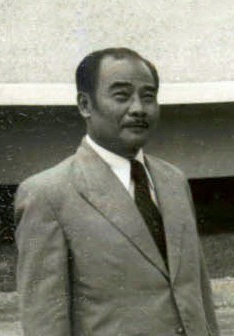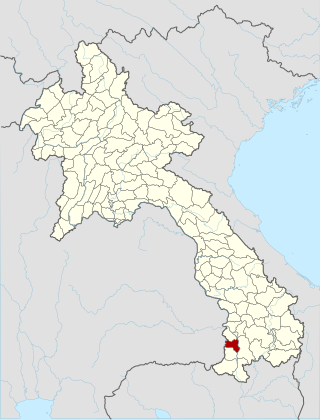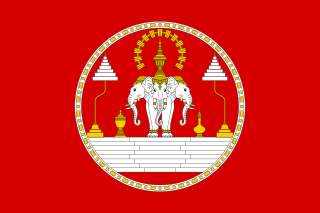
Laos, officially the Lao People's Democratic Republic, is a landlocked country in Southeast Asia. At the heart of the Indochinese Peninsula, Laos is bordered by Myanmar and China to the northwest, Vietnam to the east, Cambodia to the southeast, and Thailand to the west and southwest. Its capital and largest city is Vientiane.

Evidence for modern human presence in the northern and central highlands of Indochina, that constitute the territories of the modern Laotian nation-state dates back to the Lower Paleolithic. These earliest human migrants are Australo-Melanesians—associated with the Hoabinhian culture—and have populated the highlands and the interior, less accessible regions of Laos and all of South-east Asia to this day. The subsequent Austroasiatic and Austronesian marine migration waves affected landlocked Laos only marginally and direct Chinese and Indian cultural contact had a greater impact on the country.

Prince Souphanouvong, nicknamed the Red Prince, was along with his half-brother Prince Souvanna Phouma and Prince Boun Oum of Champasak, one of the "Three Princes" who represented respectively the communist (pro-Vietnam), neutralist and royalist political factions in Laos. He was the President of Laos from December 1975 to August 1991.

Chao Anouvong, or regnal name Xaiya Setthathirath V, , led the Lao rebellion (1826–28) as the last monarch of the Kingdom of Vientiane. Anouvong succeeded to the throne in 1805 upon the death of his brother, Chao Inthavong, Xaiya Setthathirath IV, who had succeeded their father, Ong Bun or Phrachao Siribounyasan Xaiya Setthathirath III. Anou was known by his father's regal number until recently discovered records disclosed that his father and brother had the same regal name.

Pakse is the capital and most populous city of the southern Laotian province of Champasak, and the second most populous city in Laos. Located at the confluence of the Xe Don and Mekong Rivers, it has a population of about 95,000. Pakse was the capital of the Kingdom of Champasak until it was unified with the rest of Laos in 1946.

The flag of Laos consists of three horizontal stripes, with the middle stripe in blue being twice the height of the top and bottom red stripes. In the middle is a white disc, the diameter of the disc is 4⁄5 the height of the blue stripe. The flag ratio is 2:3.

Champasak is a small town in southern Laos, on the west bank of the Mekong River about 40 km south of Pakse, the capital of Champasak Province. It is the seat of the Champasak district (muang).

This article details the history of Laos from 1945 to the present.

The French protectorate of Laos was a French protectorate in Southeast Asia of what is today Laos between 1893 and 1953—with a brief interregnum as a Japanese puppet state in 1945—which constituted part of French Indochina. It was established over the Siamese vassal, the Kingdom of Luang Phrabang, following the Franco-Siamese War in 1893. It was integrated into French Indochina and in the following years further Siamese vassals, the Principality of Phuan and Kingdom of Champasak, were annexed into it in 1899 and 1904, respectively.

Bouasone Bouphavanh is a Laotian politician who was Prime Minister of Laos from 2006 to 2010. He was officially appointed to the office by the National Assembly of Laos on 8 June 2006, during a major government reshuffle. He replaced Bounnhang Vorachith who became vice president. Bouasone had previously served as first deputy prime minister since October 3, 2003. Before that, he was third deputy prime minister and was president of the State Planning Committee. He ranks seventh in the Politburo. He was replaced as Prime Minister on 23 December 2010 by Thongsing Thammavong. Now, Bouasone Bouphavanh currently serves as head of the Lao Party Central Committee's Commission for Economic Development Strategy Research.

The Royal Lao Government was the ruling authority in the Kingdom of Laos from 1947 until the communist seizure of power in December 1975 and the proclamation of the Lao People's Democratic Republic. The Franco-Lao Treaty of 1953 gave Laos full independence but the following years were marked by a rivalry between the neutralists under Prince Souvanna Phouma, the right wing under Prince Boun Oum of Champassak, and the left-wing, Lao Patriotic Front under Prince Souphanouvong and future Prime Minister Kaysone Phomvihane. During this period, a number of unsuccessful attempts were made to establish coalition governments.

Vat Phou is a ruined Khmer Hindu temple complex in southern Laos and one of the oldest places of worship in Southeast Asia. It is at the base of mount Phou Khao, some 6 kilometres (3.7 mi) from the Mekong in Champasak Province.

Champasak is a province in southwestern Laos, near the borders with Thailand and Cambodia. It is one of the three principalities that succeeded the Lao kingdom of Lan Xang. As of the 2015 census, it had a population of 694,023. The capital is Pakse, but the province takes its name from Champasak, the former capital of the Kingdom of Champasak.

SHB Vientiane F.C. was a professional football club based in Laos that played in the Lao League, the highest division in Laotian football. The club played its home matches at the Chao Anouvong Stadium.
The 2016 Lao League is the 27th season of the Lao League, the top Laotian professional league for association football clubs, since its establishment in 1990. The season began on 26 March 2016, and is scheduled to conclude in late 2016.
The 2022 Lao League is the 33rd season of the Lao League 1. Contested by 7 clubs, it operates on a system of promotion and relegation with the Lao League 2. The season started on 12 March 2022. It is played in triple round-robin format, with 21 total rounds. Due to the new policies and regulations implemented by the newly established Laos Football League Company, there will be only seven teams in the league.
Events in the year 2022 in Laos.













